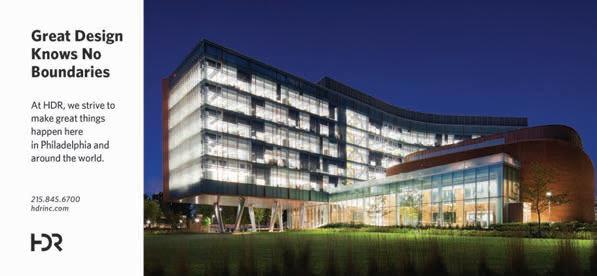
47 minute read
Construction, Infrastructure & Utilities
Construction, Infrastructure
& Utilities:
Advertisement
Uncertainty plagued the construction industry in 2020 as the pandemic put a cloud over the commercial segment. But predictions of a dire fallout failed to materialize, and by the end of the year, there was optimism that the spark would return before the end of 2021.


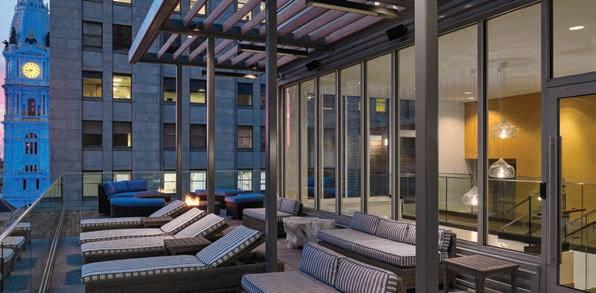
Uncertain times:
Residential leads a sector that worked under a cloud for much of the year
For the Philadelphia construction sector, this has been a time of uncertainty tempered by cautious optimism. In the last decade, the city had experienced a construction boom the likes of which had not been seen since the end of World War II but, with COVID-19, that all came to an abrupt stop. Many at the time feared a dire economic fallout. That did not materialize, and there are signs that the market could once again be robust by the end of 2021.
Major residential projects are in the works or are set to begin; infrastructure projects continue apace, with the added optimism of a new presidential administration that hopes to make infrastructure growth one of its signature legacies; and, finally, Philadelphia is fast becoming one of the national leaders in the life science industry, pushing a slew of construction in the field.
But industry observers are still unsure about where the year will go. Many of the projects underway had long since been in the pipeline. Furthermore, there is worry about unforeseen, longer-term effects the pandemic may have on the economy, or what might happen if the vaccine is not speedily rolled out.
Landscape Until the COVID-19 pandemic, the Philadelphia construction sector was considered to be on stable ground, having moved from strength to strength since the last recession in 2008-2009. This is attested by a number of metrics: there had been more than double the amount of permits issued in 2018 than in 2009; by 2018, the sector was employing a decade-high number of people, a 24% increase since the last recession. Altogether, there was a 7.6% annual growth rate in the industry from 2009 to 2019, according to the Economy League. Much of this development had been spurred on the commercial side by Philadelphia’s growing attractiveness as a repository of highly skilled labor, and, on the residential side, the return of the middle class to the inner-city after decades of “white flight.”
Among the marquee projects showcasing the boom of the last decade are 40 N. Broad Street, in the heart of Center City, where Tower Investments is redeveloping the old Inquirer building to serve as headquarters of the Philadelphia Police Department; Sora West, a $325 million office complex that Keystone Property Group is building; and the Durst Organization’s $2.2 billion Penn’s Landing development along the Delaware River.
Like everywhere, however, the pandemic has severely shaken the industry. On March 20, ( )
Sector shifts
Multifamily is booming while retail is facing significant changes
Dan Gring
CEO – D&B Construction Group
What is the state of residential demand in the Greater Philadelphia region? Right now our biggest sector is multifamily. Multifamily is booming. We have projects in the pipeline from now until 2024 and we’re involved in preconstruction services for many of them at this time.
There are some cool trends in multifamily right now. Concerning amenities, we’ve seen an expansion of coworking spaces in response to the current times. Some business owners have found their staff to be just as efficient working remotely as they are in an office. That’s been a big amenity shift for us in the multifamily sector.
How has retail transformed over the course of the pandemic? Retail is changing significantly. Many retail projects are on hold but some are trudging forward. The layouts of the stores are changing. For instance, more cash registers are being put into the stores to reduce the size of lines and assist in social distancing efforts. Some retail stores are also downsizing. We had one project downsize by about 40%. COVID-19 has accelerated the use of e-commerce. People have become accustomed to ordering things online. Retail owners have had to strategize and adapt to our current times, as well as what they could be in the future.
Why are developers beginning to implement a designbuild approach? Because of our big push in multifamily, we’re doing a lot of design-build. Developers are starting to realize that they need to get their general contractors in early instead of the old traditional full bid out, competitive bid situation. When we’re involved with the architects and engineers early in the project, we’re able to make it a more successful project for the developers. This helps to better deliver their vision. How is demand for o ce space faring? Certain markets are still performing. For instance, in the Bucks County market, we’re still seeing an abundance of demand for new space or updated space. In Philadelphia, demand for office space has dried up. Concerning office demand, there’s not much in Downtown Philadelphia. It’s great in Bucks County and completely dead in Reading.
What is your outlook for D&B Construction Group? We are one of Greater Philadelphia’s fastest-growing businesses, and we’re tripling our space. Although the pandemic has posed a variety of challenges for us, we’re continuing to expand our presence and deliver. We were also voted best place to work in PA by the Central Penn Business Journal.

Scott Zuckerman
Principal Domus Construction
Where do you expect to see the most new development emerge in Philadelphia?
I think what we’re going to see is a lot of repurposing. “Repurposing” is going to be a big buzzword in the real estate industry. I believe o ce space and restaurants in Philadelphia are going to take a hit. A lot of companies are going to realize that the workstation concept does not work with social distancing and in many instances their employees can work e ciently at home, reducing their square footage needs. I don’t know how those spaces will be repurposed but the o ce model that people followed 15-20 years ago, where everyone comes into the o ce everyday, is going to go away. Universities are another area that will change. I think they’re going to be looking for more student housing. Gone, hopefully, is the model where universities try to fit five or six kids into a dorm room. They are going to want to split that up and have maybe two or three students per room. So I feel that we are going to see some demand for additional student housing. Philadelphia is a little tricky because we have more commuter colleges but there is a significant population of students who live on those various campuses.
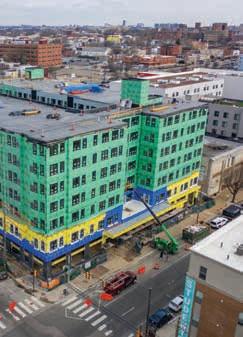
What kind of impact do you think COVID protocols will have on residential developments?
I don’t know if it will have a huge impact on multifamily. I think you will see some reduction in lobby space where people traditionally congregate and some shared amenity spaces and you will see an increase in surfaces that are easier to disinfect. I expect to see improvements in ventilation systems. There has been a lot of talk about UV systems to help kill bacteria in the air. For the most part, layouts are going to remain the same in the multifamily sector.
I have this discussion every day. People are social creatures and they want to be socially interactive. They’re not going to want to be locked up in their o ces or homes like they currently are. People are going to crave interaction.
State housing permits in Philadelphia have started to recover to almost pre-pandemic levels.
( ) Gov. Tom Wolf halted all non-essential work in the state, which included any construction projects that were not regarded as medical-related, emergency work or, in limited cases, residential construction. This move in itself was controversial, as Pennsylvania was one of the few states in the country to deem construction non-essential.
The industry struggled. With nearly 20,000 construction jobs in Philadelphia alone – plus two indirect support jobs for every one direct construction job – everyone knew the stakes were high. The government, which derives a significant amount of revenue through fees related to construction permits, licenses and inspections, worked with the industry to help keep it afloat, either by supporting furlough pay, by granting waivers that would allow certain construction projects to continue work, or by issuing safety guidelines protecting workers on site. Even with the help, supply chains were affected, as was access to labor.
With stringent safety measures now put into place, the industrywide shutdown gradually began to be lifted on May 1. While analysts are now looking to predict what the recovery will in fact look like, one thing is for certain: the dynamics and trends that had
marked the industry over the boom of the last decade are irrevocably changed. The speedy recovery after the 2008 crisis was largely driven by middle class professionals or millennials moving to inner cities. There are still many questions as to who or what will drive the post-pandemic recovery. This is true especially in regard to the tourism and hospitality industries. Typically, these are big drivers of largescale construction projects but they are also likely to be the slowest in returning to pre-pandemic levels.
Still, as the rapid vaccination drive is unrolled and a massive relief package makes its way through Congress, there is plenty of reason for optimism. Not least among these is the rapid decline of unemployment in the region, which was at 14.8% in April during the height of the lockdown. From there, the rate embarked on a steady improvement, falling to 6.5% by December.
Furthermore, certain trends accelerated by the pandemic bode well for Philadelphia’s construction sector. The last few years have seen a number of corporate relocations to the city. Healthcare and life sciences, already a big driver of construction in the region, are poised to see growth in the coming years. Indeed, some forecasts show that construction in these sectors will provide the most growth in terms of total construction market volume over the next two years.
Such forces will continue to draw young professionals to the area. It has a high quality of life, a vibrant city center and is a much lower cost alternative to nearby New York City and Washington, D.C., both for living and construction, a fact that makes it an ideal location for development on the Eastern seaboard. The exodus away from such high-priced cities was notably absent in Philadelphia. The move toward online and remote work, greatly accelerated by the pandemic, dovetails nicely with Philadelphia’s status as a city for younger, highly skilled professionals. In light of these trends, it makes sense that, over the past five years and for at least the next two years, the residential sector will continue to deliver the highest market volume for the construction industry.
Performance The performance of the Philadelphia construction sector has been driven by projects in healthcare, multifamily residential complexes, data centers, corporate offices, industrial construction and the
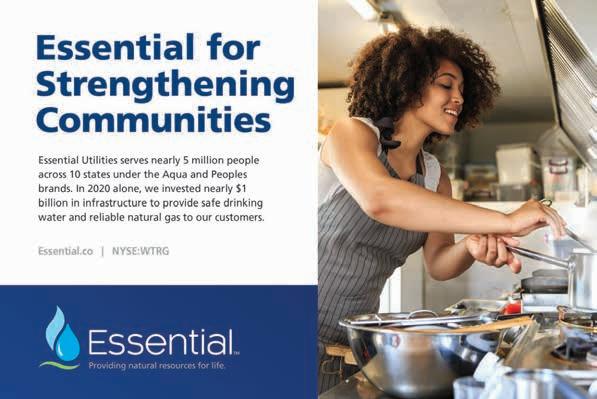
Mike Starck
Vice President NRG Retail
How have client needs evolved in recent years?
As customers become more educated on energy there are di erent priorities for energy consumers. Some are focused on the renewable aspects while others are focused on the benefits they can get from being a retail customer, which can come down to a company’s values. We have product o erings with 100% green, renewable energy certificates and we have farm-tomarket o erings. We also o er carbon o sets for customers who are unable to install solar panels on their homes but still want to play a role in protecting the environment. Everyone wants to have access to renewable and sustainable products and people are thinking about how to use energy wisely. On the more commercial side, capital investment plays a large role in decision-making. Our team is trying to focus on creating solutions that are less capital-intensive for some of our customers. Everyone wants to have fully renewable power but there are issues such as reliability, large initial investment and time. Our plan allows customers to make those choices without necessarily having to make a large upfront investment.
How does the carbon offsets program help combat climate change and also benefit customers?
We provide a simple website with a carbon footprint calculator that allows users to calculate their carbon production on a monthly basis. Our carbon o set o ering allows our customers to do things that o set daily activities with something that benefits the environment, such as plant trees. Our goal with this program is to allow customers to o set impacts when they are not necessarily able to make a huge investment. Those that are able to install solar panels or purchase an EV are often those with a lot more means, and we want to make carbon o setting attainable for all. A few years ago, we partnered on an event with South by Southwest to take responsibility for its carbon o set. This is really important for large events, but we are taking this concept and making it more accessible to everyone. renovation of older structures. Throughout 2020, the sector’s ability to survive was marked by an adaptability to oncoming challenges. Foremost of these was in the area of worker safety. As construction is one industry that depends on people showing up to the site, the sector had to address this challenge head on. In order to meet the unprecedented challenges posed by the COVID-19 pandemic, an initiative was spearheaded by the General Building Contractors Association (GBCA), the Philadelphia chapter of the Associated General Contractors of America, to ensure the safety of workers on-site. In addition to providing training, the GBCA recommended new protocols concerning workers’ personal responsibilities, health screening, social distancing and personal protective equipment.
The permitting process for new construction in Philadelphia has made the jump online. Ironically, that move was due to take place on March 20 – the day the COVID-19 lockdown began – and it went off without a hitch.
Since construction was allowed to resume in midMay, many have been wondering what the direct impact of the coronavirus pandemic will be on the industry in 2021. While construction seems to have returned to prepandemic levels, many of these projects were already underway – or, at least, the financing had already been secured – before the crisis struck. There have been telling signs of a slowdown moving forward. For instance, demolition work dropped by more than half over 2020, suggesting that there may be a slowdown in building in the coming year or two and that the fallout from the pandemic may take longer to manifest than previously expected. Many on the commercial side fear that the emergence of remote work, a trend that was catalyzed by the pandemic, will reduce demand for office space.
Overall, and not surprisingly given the pandemic, construction volume fell year over year in 2020, according to the Cumming U.S. Construction Market Snapshot Q4 - 2020 report. Total volume amounted to $16.9 billion for the year, down 2.3% from 2019. Residential took the lion’s share of the market, at $4.8 billion, rising 1.0% from the prior year. The segment was one of only two areas that saw growth. The other was infrastructure, which gained 2.4%, although Cumming expects this segment to decline by 8.3%, 5.1% and 5.0% in 2021, 2022 and 2023. Manufacturing saw the biggest volume loss, falling 11.2%. A similar decline is forecast for 2021. Construction spending in Philadelphia was lower than the U.S. average but above the state of Pennsylvania. The reading of the Construction Spending Index was just above 1.0 for Philadelphia. The U.S. average was just above 1.2. ( )
Vaughan Buckley
President Volumetric Building Companies
As we move further into health and safety considerations that have come up around the pandemic, we’re going to see many more smaller, private units. The large common amenity spaces are shifting toward larger units with space inside them. Technologies that allow us to save space, whether that is a construction method such as modular construction or design implications and potential future technologies such as stackable furniture and movable divider walls and things of the sort, they are all high-potential products as we move forward with new technology.
We doubled down on other strengths and expertise and training. We built out, in a very short time, a very robust online training platform, including live webinars,video-training, and self-directed learning, with di erent tracks. One was COVID-19 related: We provided a free, open resource on how to deal with COVID 19, the protocols and laws that came along with it, and we saw well over 2,000 registrations through that series.
Ben Connors
President & CEO General Building Contractors Association
Todd Lofgren
Executive Vice President & General Manager Skanska USA Building Company
Internally, we utilize our data harvesting and benchmarking tool – Skanska Metriks – which provides us with accurate benchmarking budgets based on comparable data from hundreds of projects in the markets we serve. Skanska Metriks delivers an early benchmarking budget to our clients to help guide budget discussions and design systems. Our focus on relevant details enables us to arm project teams with critical information during the early phases of design, which ensures your project budget compares appropriately to similar projects. This tool allows us to better inform ourselves, our partners and our clients.
Our o ce is now touchless. In the restrooms we have a single fixture faucet with built in soap, wash and dry all within the sink. There are foot pedals to open and close push/pull doors. Employees working in the field have access to our project management software with their smart devices. Time sheets are electronically sent to our payroll system through a customized app. A&E utilizes a paperless system for receipts and invoices and electronic signatures whenever possible. Our job sites are monitored with surveillance cameras. All of this technology is available in today’s construction world. Bill Santora
CEO A&E Construction Co.
Clean push
Philadelphia utility is focused on initiatives related to carbon recapture and maintaining a healthy environment

What are the utility’s main ongoing initiatives? We have a lot of initiatives that we want to continue addressing. These include those issues related to carbon recapture and keeping the environment clean and healthy. PGW and a lot of other utilities have been way ahead of the game in terms of reducing our carbon footprint. Of our 500,000 customers, around 480,000 are residential. These customers used approximately 35-40% more natural gas when I started than they do today, largely due to the increased efficiency of appliances. We also offer energy audit programs for lower-income customers to ensure energy efficiency enhancements are made. Since 2010, PGW has weatherized nearly 22,000 low-income customer homes and over 22 multifamily buildings where the majority of tenants are low income in Philadelphia.
Another important investment is our ongoing castiron replacement program. We have approximately 1,300 miles of cast iron pipelines remaining in our system. We are replacing this with welded steel or plastic, which in both cases completely eliminates methane escape. From 2005 to 2019, these upgrades have lowered CO2 emissions by 86,000 metric tons, which is equivalent to the emissions of a passenger vehicle driven over 211 million miles. A fourth area we are looking at is our own building footprint and we are consolidating a lot of older facilities. The final area we are looking at is the further development of our liquefied natural gas (LNG) assets, which can replace dirtier fuels such as coal. We will continue to pursue and expand those initiatives.
What opportunities have you identified in the utilities sector? We are about 85% saturated in Philadelphia with natural gas being used to heat homes. The market for us is still pretty significant but where we are expanding is in the combined heat and power market. It’s much more efficient and we can create situations where we can serve multiple clients from the same location.
Our product is our tariff, which is a rate structure that has been approved by the public utility commission. We have created a series of incentives for businesses to move to a cleaner incentive. We are also working on a diversification study for Philadelphia Gas Works in cooperation with the city of Philadelphia’s sustainability department. We’re evaluating every option and we want to do something that is both financially viable and has a significant positive impact on the environment. Our financial future is very much tied to the city’s well-being, so we have to make smart decisions.
Craig White
President & CEO – Philadelphia Gas Works
( ) Residential As usual, the residential segment underpinned the industry, bouncing back after the market froze during the COVID-19 lockdown in spring 2020. There are thousands of new homes being developed. The market remains strong: houses sold quickly even during the dark days of the spring lockdown. For the year, houses stayed on the market for a median 15 days, a 10-year low. Much of this growth is the result of young professionals and middle-class workers moving to the city, attracted by high-skilled jobs and a cost of living that is relatively lower than other city centers. There is a strong demand for multifamily housing complexes. As well, the neighborhoods in the vicinity of Philadelphia’s many universities have seen a high occupancy rate in spite of the coronavirus pandemic sending many students home.
On the whole, the numbers appear strong. While there is something in the idea that during a pandemic, people will not want to live in a densely populated area, this is not completely founded: the vacancy rate in the suburbs may have seen a jump to 5.2% in June 2020, up from 3.8% a year prior, but in Center City there was also a slight increase to 4.5% occupancy. While rent growth is expected to be lower than the average of the past few years, it is expected to grow nonetheless. Additionally, Philadelphia is second in the nation for apartment conversions in historical structures: in the last decade, 85 properties converted into multifamily housing produced 11,266 new housing units.
So there is a demand and the construction industry is working to be meet it: the Southfields of Elkton is a $700 million, 600-acre mixed-use development that will contain residential units as well as retail and office; on South 12th Street, next door to the Camac Baths building, there is a tower going up with 448 residential units; on 22nd Street, another will contain 341 units.
Given the pandemic, it can be difficult to gauge the forces behind this growth. Depending on the metric, some of it can be attributed to a gradual reopening of the construction sector generally as many projects already in the pipeline were put on hold. A case in point would be the Zoning Board of Appeals (ZBA). While construction restarted in May 2020, the ZBA only started hearing cases again in July after being shut down for four months. On the board’s docket were 50 hearings scheduled for developments containing at least five units, amounting to 2,436 new units if they all
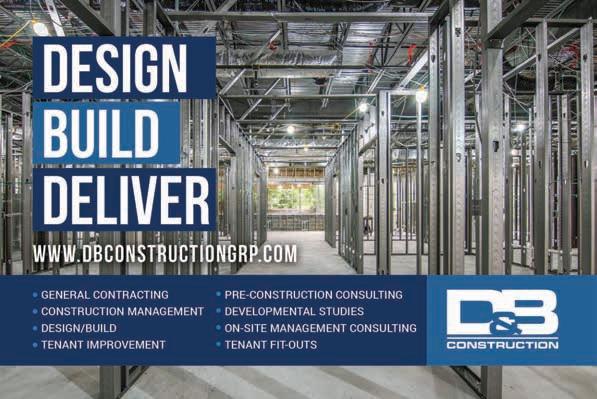
Chuck Hurchalla
President Evolution Energy Partners
How have you seen the demand for renewable energy change over the last couple of years?
The demand for renewables is definitely becoming more and more critical on the supply side through the adoption of sustainability initiatives. It’s a positive sign to see that in many cases our points of contact are now directors of sustainability, whereas in the past it might have been a plant manager or a CFO. Only a few short years ago, the position of director of sustainability was unheard of, so this has been a significant change. In the past, our business model was primarily focused on helping our customers reduce their energy consumption and lowering costs purely for the economic benefit of doing so. Now, as mindsets have expanded, the green of the dollar is not the sole driver anymore. The green of the environment is also imperative.
What trends are you keeping a close eye on?
From an energy perspective, the increase of shale production of natural gas has been game changing for Pennsylvania. It has created an enormous amount of growth for the energy business as well as lowering the cost of operations for manufacturing and commercial accounts in respect to their energy expenses.
We are also seeing states and cities creating laws and regulations to mandate energy e ciency and sustainability. State and local governments are requiring government-owned and privately-owned commercial buildings over 20,000 or 50,000 square feet to benchmark their energy use and carbon footprint and to make improvements to both within specified time frames or else be penalized. On the utility side, states are requiring that a percentage of the grid’s electric load be generated through renewable energy sources such as solar, wind and hydro. The government requirements combined with companies’ corporate sustainability mandates and the need to cut costs will absolutely result in significant carbon footprint reductions across all sectors and we are looking forward to helping our customers and doing our part.
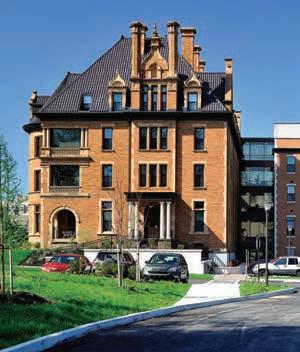
Philadelphia is considered one of the Top 19 knowledge capitals in the United States and Europe.
pass. That is not bad when compared to pre-pandemic 2019 (4,566 new units) and 2018 (3,239). Additionally, this only includes units that have to pass the zoning board; the true number certainly is higher.
One area in which the city is continuously lagging is in the construction of affordable housing. The pandemic has only underscored the inequities in Philadelphia’s housing as it has disproportionately affected low-income renters and homeowners. To help fight this, the city has launched a number of initiatives to encourage the construction of homes for Philadelphia’s lower income residents. Among these are a 1% development impact tax, the proceeds from which will go to build affordable housing; to delay the reduction of a 10-year tax abatement; a reduction of the tax abatement for commercial construction; and, finally, a $400 million bond package that would help fund the construction of affordable housing.
Commercial and industrial The big question affecting the commercial construction sector is whether or not people will be returning to the office after the pandemic sparked a revolution in at-home working. The general consensus at this
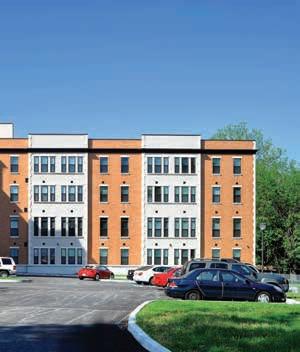
point is that it is too early – the data is too sparse – for there to be anything conclusive. Furthermore, it could go both ways: just as there could be a trend toward more working from home, there could also be demand from employees at the office for more physical space, a result of needing to feel safe in the workplace. “The big shift that folks are anticipating is that anybody who was in the market for new office space is now kind of second guessing their search, because they already are seeing more demand for suburban office and environments. This is for two major reasons. With anything in urban areas, a large portion of employees typically use public transportation, which has now become a major risk. The other major disruption is elevator capacity. In a taller building, most people use the elevator to get to their office on the 20th floor. Under the new guidelines, an elevator designed for 15 people might only be allowed to carry four people. If you have to wait one hour to get on the elevator, that’s going to cause disruptions for those people,” Matthew Cleary, territory manager at SageGlass/Saint-Gobain, told Invest:.
One factor is evident regarding office spaces, and that is that technology developments are influencing demand in every way. “Technology has tended to lower the demand curve, whether through allowing for higher density or allowing for remote work. Moving forward, we will likely see these trends continue. It means that traditional office space developed over the last 75 years has increasingly become obsolete, in terms of what it looks like, the features it offers and where it’s located. Companies are realizing that, for a host of reasons, different workplace environments are necessary going forward. So, while total aggregate demand will be dampened, it does not mean that there will not be demand for new facilities. In many respects, that is a new opportunity for creators of space who can understand those features that are desired,” said John Gattuso, president and CEO of Gattuso Development Partners.
Also emboldening the sector is the possibility that there is pent-up capital – on both the debt and equity sides – that investors have been sitting on during the pandemic and who are now keen to invest in commercial real estate projects. The possibility of pent-up savings waiting to be unleashed also applies to the retail sector, and some analysts are bullish that 2021 will be the beginning of a strong consumer cycle. Both of these outcomes are predicated on the ( )
Perspectives: Hospitals
Carl Davis
CEO – Array Architects Health systems have su ered throughout this pandemic market as elective surgeries, their path to profitability, have been on hold. Hospitals can’t survive without elective surgeries. Additionally, care has been postponed, causing an additional strain on health systems. At some point, hospitals will have to deal with this issue. When this happens, many of our projects will come back online. There are various opinions on the rollout of the COVID vaccine and its impact on healthcare overall. I think this will resume a great deal of normality.
Angelo Perryman
CEO – Perryman Construction The marketplace is coming back slowly but surely. There may not be new demand for healthcare as a result of the pandemic, but there is higher demand for a skilled and prepared workforce. We are not sure about the quantity of demand for all service providers, but there is a huge focus on the ability to deliver in a safe and organized manner. For every type of project, there has been more demand for providers who can deliver on health and environmental safety.
®oundtable: Energy plans
Energy utilities play a pivotal role in daily and business life. Here is how market leaders are making a difference in the region.
Bill DiCroce
President & CEO Vicinity Energy
How is Vicinity Energy helping to reduce carbon pollution and maintain a clean environment? In Philadelphia, our district energy system and combined heat and power (CHP) plant are the largest in the state at nearly 170MW. We distribute clean, low carbon energy to over 400 buildings, totaling 96 million square feet of building space in Downtown Philadelphia — equivalent to 61 Comcast Technology Centers. Our district energy system can exceed 80% e ciency as compared to traditional modern power plants that are only 50%-60% e cient. Annually, that carbon avoidance is over 300,000 tons per year. As Philadelphia develops, for every million square feet of building space that signs up with us, approximately 3,500–5,000 short tons of carbon will be avoided annually compared to conventional methods. Going forward, we have various initiatives to further our green imprint on the community. For example, this year, we’ve entered into contracts to eliminate use of heating oil in our facilities and replace it with locally sourced biofuels.
What is your biggest challenge in the region? Getting people to understand who we are and what we do is our biggest challenge. Along with communicating and educating the business community, we’re also working with the government so that they understand what we can o er and how they can use us as an existing infrastructure in achieving their net neutrality goals. As the city grows and attracts new types of industries, like the life sciences, our system will be able to reduce carbon by up to 5,000 tons of carbon for every one million square feet annually.
Mike Innocenzo
President & CEO PECO
How are your green initiatives impacting the region? As the needs and expectations of our customers and communities grow, we must continue to grow with them. A key focus of creating a greener and more sustainable region across Greater Philadelphia is renewable energy, such as solar and other resources, and the electrification of transportation.
We are taking several steps to help grow and promote electric vehicles in our region. PECO’s fleet includes approximately 1,200 hybrid, natural gas, electric, flex fuel and biodiesel vehicles. We are also supporting Senate Bill 596, which would establish a state goal of a 50% increase in transportation electrification by 2030 and would enable us to build out a broader electric vehicle charging network.
We put together a team that is dedicated to solar and renewable energy resources, which ensures that we make it easy for customers to make the decision to install solar energy infrastructure, through an online application process and project tracker. We are working on further legislation that would increase some of the solar electricity targets for the state of Pennsylvania.
How is PECO working to improve its treatment of weather-related outages? We know that more severe weather is impacting our region and our infrastructure. Two of PECO’s Top 10 storms in company history occurred this year, with the June Derecho and Tropical Storm Isaias in August. We are continuously working to enhance our system to make it more resilient and better withstand extreme weather.
Emily Schapira
President & CEO Philadelphia Energy Authority
What role does the PEA play within the Philadelphia region? The PEA is an independent municipal authority. In 2016, we launched our marquee initiative, the Philadelphia Energy Campaign, a 10-year, $1 billion investment in clean energy and energy e ciency projects to create 10,000 jobs. We’ve helped launch over $150 million in projects since the launch of that campaign and through 2019, we created about 1,300 jobs. We view our role as helping to create a robust, equitable clean energy market in Philadelphia, and we’ve seen that market really begin to blossom.. We’ve been able to create and implement several tools that help the market move forward, like Commercial Property-Assessed Clean Energy financing (C-PACE), a commercial-industrial financing tool, and with Solarize Philly, a residential solar discount program that helps fund solar training for youth and access to solar for low and moderate-income homeowners. We have helped foster significant change in the way people think about the energy market here.
How would you characterize the dynamic between clean energy and public health? Clean energy drives public health by improving both indoor and outdoor air quality. Our reliance on fossil fuels has led to Philadelphia having one of the highest rates of childhood asthma in the nation, which will be greatly reduced by the recent closing and current redevelopment of the East Coast’s largest oil refinery. And as we’ve seen with COVID-19, indoor air quality and healthy conditions at home are more important than ever, and energy and utilities have a huge role to play. How is WGL Energy impacting Philadelphia’s energy sector? WGL Energy is a competitive retail supplier serving the mid-Atlantic region. We have been in business in this area for over 20 years and we serve approximately 200,000 customers. Here is where WGL Energy fits in to Philadelphia’s energy sector. When you think of your electricity or your natural gas bill, the local utility will distribute the commodity. However, in a competitive market like Pennsylvania, the generation and transmission of that commodity is open for competition, and consumers have the ability to shop for that service. That is what we provide. We o er those competitive retail services to energy consumers in the Philly area, everyone from residential consumers to the buildings of the city of Philadelphia itself, including the airport. We also o er consumers the ability to green their commodity purchases by adding 100% renewable wind energy to their electricity purchases or adding 100% carbon o sets to their natural gas supply.
What is your outlook for the industry in Philadelphia? I think there is a lot of opportunity for consumers to take control of their energy spend as COVID restrictions are lifted. Philadelphia is located in the PJM deregulated energy territory, which is supplied by a variety of generation fuel sources and has a di erent market structure than ERCOT in Texas. The diverse fuel mix and longer-term PJM market signals give consumers a better opportunity for grid reliability, but energy e ciency and resiliency will still be important as Super Storm Sandy is still a recent memory for some of us.
Clint Zediak
Vice President of Sales and Marketing WGL Energy
Digital advantage
The prevalent use of technology and the ability to work in the cloud proved pivotal in the pandemic landscape

HDR specializes in design through digital technology. What technology do you use and how is it used? We use building information modeling (BIM) and project information management tools throughout our project delivery. Specifically, we create our design and documentation models using Autodesk’s Revit platform, which is common in the industry. Fortunately, when projects permit, our work can be done using cloud-based collaboration. This has really helped us, especially now, while our teams may be distributed and need access to the same model(s), regardless of whether they are sitting in the office, the jobsite or at home. This type of BIM collaboration really streamlines our workflows and makes it possible to make alterations in near real time. We also use Bluebeam Revu to mark up the drawing sets to both coordinate information within our team and with our consultants. These tools have allowed our teams to transition into remote work fairly seamlessly.
What modern trends in building engineering do you expect to emerge in 2021? I think some trends will probably be more pronounced, such as prefabrication or off-site fabrication. We’ve already started to incorporate that into some of our projects. It’s becoming more and more important as contractors get more accustomed to it since it helps shorten the construction period, which equates into financial savings. Really anything that saves time or makes it more efficient for construction will find a way to be incorporated. The industry is also being pushed to innovate with smart buildings, sustainable designs and other touchless technology, and HDR is collaborating with our clients to make this goal a reality.
What are some of the challenges or unique opportunities for the architecture industry in Philadelphia? One of the main challenges for the architecture and engineering industry in Philadelphia is the cost of construction and labor. Construction and labor costs are quite high but leasing rates are relatively low in comparison to other major cities. So it’s difficult for clients or developers to be able to get the return they need relative to the investment they require for a new building. So that is always a challenge.
Architects design to a certain budget, which can limit the types of materials or palette they are able to use. However, I’ve found that our architects at HDR enjoy the challenge. That’s where creativity comes into play.
Elizabeth Mahon
Managing Principal – HDR Philadelphia
Robert Zuritsky
President & CEO – Parkway Corporation
Congestion and taxation were the main threats before the pandemic. As the world transitions from retail purchasing to delivery purchasing, the limited roadways we have will have to deal with all those deliveries. Uber and Lyft are another challenge. They’ve been given free reign of our streets with almost no regulation. Only New York has limited the number of drivers they will allow to sign up, while taxis are completely regulated. Taxation at 25% of our gross plus Use and Occupancy taxes, make development of new parking cost-prohibitive, so I fear shortages as development reduces supply and increases demand. These challenges fuel our commitment to innovate faster and operate better than our peers.
( ) successful rollout of the vaccine. “Obviously, retail is struggling right now. I do not believe that online shopping will be the end of brick and mortar stores. What is needed is to provide a great user experience for shoppers. We have been active for 20 years with the redesign of struggling malls into lifestyle centers to include restaurants, apartments, medical offices, entertainment, and public activity spaces. These redevelopments provide a unique opportunity to introduce outdoor areas for seating with passive recreation, dynamic outdoor dining areas for restaurants, and healthy lifestyle activities, amenities with walking trails and dog parks. I believe this trend will only get stronger,” said Jim Riviello, principal and partner at The Martin Architectural Group P.C
Philadelphia is also among the vanguard cities of a life science construction boom across the nation, where there is a low laboratory vacancy rate at the moment and up to 36 million square feet of new construction expected in the coming years, all indicating great demand. In the United States, life science investment as a percentage of total office volume reached 16.4%, more than double the previous year. Philadelphia is poised to take advantage of this boom. Thanks to its many universities, healthcare institutions and a legacy of pharmaceutical manufacturing, the industry performs well here on a number of metrics: market maturity, wet lab inventory, rental rate, vacancy rate, tenant demand and venture capital funding. Currently, there are more than a million square feet of life science space under construction in the city and – with rising tenant demand – growth is expected in 2021.
In industrial construction, too, Philadelphia is looking strong. The pandemic did not have a huge effect on manufacturing levels generally; employment in the sector is below 5% and output is at or above pre-pandemic levels. The numbers speak for themselves: active industrial construction rose by 15.4% since 2019 to 21.4 million square feet by the end of 2020 and 50.3% of this is preleased. Industrial delivery construction did extremely well, setting records in demand, which is outpacing supply, and leasing, despite the pandemic and the subsequent downturn. The industrial market regionally had a very strong year, too. While the vacancy rate increased in the last two quarters, this was mostly due to 12.5 million square feet of speculative construction being completed; one-third of this has already been leased. Additionally, the supply of legacy space has become increasingly limited.
Despite a serious battering from the pandemic, even the hospitality sector managed to score some victories, with a few marquee projects opening during these hard times: the Hyatt Centric Center City Philadelphia, an $81 million hotel with 332 rooms located in the heart of Rittenhouse Square, and the 510,000-square-foot, $700 million Live! Casino & Hotel Philadelphia both opened during the pandemic. While this is surprising, it should also be noted that such projects groan under mountains of debt and developers are unsure of the way forward. All of this, again, depends on a speedy rollout of the vaccines. ( )
Jeremy Grey
Executive Vice President, Industrial Development – Hilco Redevelopment Partners
Even during this pandemic, the demand for the life science, light industrial, research and development, e-commerce and light manufacturing market sectors have been strong. The coronavirus pandemic has put these asset classes at the forefront. The pandemic has pushed many shoppers to make their purchases online and has changed the way consumers purchase goods. The spread of the virus and resulting economic volatility has highlighted the significance of the life science sector. While o ce has declined, that represents a very small sector of Hilco Redevelopment Partner’s platform.
( ) Legislation On the legislative side, there was a 10-year tax abatement on new residential construction that was scheduled to expire on Dec. 31, 2020. To help spur the continuation of residential construction through these uncertain times, the Philadelphia City Council proposed legislation that would delay this by several years. Already, there had been a rush to secure permits prior to the abatement. This in itself shows confidence in the market: if a company secures the site and breaks ground now, it will take up to two years to deliver the finished product and, by then, the housing market will be up to strength.
The city, as detailed by Plan Philly, is also levying a “Development Impact Tax” of 1% on all “construction or improvement costs” that require a permit. The tax applies to anything from building a new building to just getting a new certificate of occupancy. The hope behind such a move would be to raise funds that would help develop affordable housing. The city government has a plan to finance $400 million in new bonds for housing and other anti-poverty measures. The implementation of this tax has been delayed until Jan. 1, 2022, and it will not apply to projects that have completed their approval processes and applied for building permits prior to this date. There are some exemptions to this tax, such as sites benefiting from the Keystone Opportunity Zone, from purely public charity tax status, or “preparing an existing residential rental unit for turn-over to a new tenant.”
Tech innovations Many in the construction sector, hoping to best position themselves for a post-pandemic economy, are looking at including aspects of servitization in their design; that is, developments that include an array of services to offer its customers (not just office or residence space). Such features should help ensure a revenue stream for property owners through hard times such as these. According to the Engineering News-Record, construction companies are now transforming from their traditional iteration to “asset lifecycle service providers, able to provide through-life service, facilities management, and maintenance to their clients.” In Philadelphia, this trend is manifested in the groundbreaking of the first tower at the Brandywine Realty Trust’s $3.5 billion “innovation hub” at the Schuylkill Yards development. This multifunctional project will include luxury apartments, life science and office space, indoor and outdoor amenities, retail, a lifestyle club and groupworking spaces.
Challenges Besides the obvious challenges of an uncertain market in a global pandemic, the industry has been facing a lack of available talent, according to a study in which 80% of contractors were having problems filling craft positions. To meet this challenge, construction companies and the GBCA have engaged educational institutions on an unprecedented level to ensure a steady stream of talent. Among these are the ACE Mentor Program of Greater Philadelphia, in which highschool students are encouraged to look toward careers in architecture, engineering and construction; Mercy Career & Technical High School offering programs that educate in the building trades; and other apprentice programs for construction and carpentry. ( )
Transformation
Utility completes a transformative 2020 while remaining committed to providing safe, reliable services
Christopher Franklin
Chairman & CEO – Essential Utilities, Inc.
What were some of Essential’s significant projects in the Philadelphia region during this past year? 2020 was a transformative year for Essential. In February we changed our name from Aqua America to Essential Utilities. Our New York Stock Exchange ticker is now WTRG and we will celebrate 50 years on the NYSE in 2021. In March, we closed the acquisition of Peoples and became one of the largest water, wastewater and natural gas utilities in the country. Aqua is our water and wastewater brand and Peoples is our natural gas brand.
The closing of the Peoples acquisition happened on the same day our company transitioned to a work from home model due to the COVID-19 pandemic. As essential workers, about two-thirds of our employees stayed on the job and worked with new safety protocols and PPE. Although it is not necessarily a project, it is truly one of the most significant achievements of 2020.
Another very exciting project that started in 2020 is the construction of a brand new, state-of-the-art water quality laboratory that will sit at the site of our Bryn Mawr headquarters.
How is Essential helping to reduce pollution and maintain a healthy environment within the region? Essential has a long-standing commitment to environmental stewardship and sustainable business practices. It is part of the company’s mission and vision. In early 2021, we announced our commitment to substantially reduce Scope 1 and 2 greenhouse gas emissions. By 2035, Essential will reduce its emissions by 60% from its 2019 baseline. This reduction is roughly equivalent to the emissions from 76,000 cars on the road over the course of the year. Our water utilities in New Jersey, Pennsylvania, Ohio and Illinois will buy all of their power from renewable sources beginning next year. What are top priorities for Essential within the Philadelphia region for the next 12 to 18 months? Continuing to provide safe and reliable water, wastewater and natural gas service to our customers will remain top priorities for Essential. All other priorities are designed to support that commitment. Over the next 12 to 18 months we wil invest approximately $1 billion in our communities’ water and gas main infrastructure across Essential’s 10-state service territory; work toward our emissions reduction targets; increase our employee and supplier diversity; actively pursue acquisition opportunities; invest in our communities by making targeted contributions from The Essential Foundation; and continue to keep our employees safe and the company strong through the pandemic.

Dave DeLizza
President & CEO Pennoni
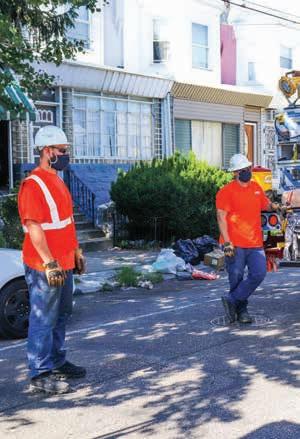
What is the outlook for public sector projects?
One of our concerns going forward is funding for public sector projects. For example, toll revenues are down for toll agencies, and that’s how they pay for their projects. Coming into the second half of 2020, we were concerned about public sector projects stopping, and while some construction did stop, the good news is that it was only temporarily delayed. This year, as we look at our budget, we still have some concerns about the public sector. We are cautiously optimistic and our public sector clients are taking things the same way. As vaccines roll out and people get back to work, I think you’ll start to see that pent-up demand in the second half of the year.
How is Philadelphia approaching sustainability and resilience?
As engineers, when we build projects, we build them to last 50 years or more. We’ve always built things to be sustainable and resilient. Those words have become buzzwords not only in construction but in every business. We have a lot of clients that are looking at sustainable and resilient development. We approach this by providing a cost-benefit analysis of various construction options, and then they can make a financial decision on what works best for their project, which our engineers take into account. Resilience in Miami, for example, is a bit di erent than resilience in Philadelphia.
What are some examples of Philadelphia’s redevelopment?
There are entire blocks being demolished and replaced with new housing in the neighborhood I used to live in. The city is improving and creating new infrastructure, transportation, bikeways, roads, and renewing many utilities as well. There’s a great deal of interest among investors to redevelop sites within Philadelphia. Real estate is still reasonably priced compared to other metropolitan areas.
Philadelphia has initiated a “Climate Action Playbook” that has committed the city to becoming carbon neutral by 2050.
( ) Gentrification, as in major cities across the country, poses its own challenges. As higher-skilled workers move into denser urban neighborhoods, residential and economic dislocation of long-standing residents – too often ethnic minorities – ensues. One Philadelphia real estate firm is hoping to meet this challenge by seeking to raise $1 billion over the next decade to redevelop Black neighborhoods across the country. Its first project is Tioga in North Philadelphia. This firm, TPP Capital Management Group, is planning to develop 1,400 residential units, 172,000 square feet of retail space and 92,000 square feet of street improvements.
Infrastructure & utilities Infrastructure, second only to residential in terms of market volume, is another area poised to keep the
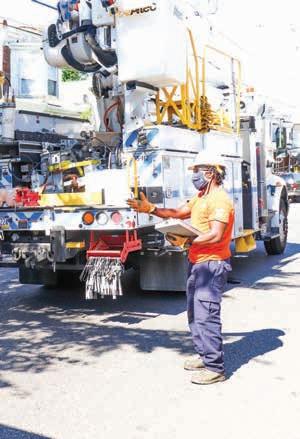
Philadelphia construction sector humming for the foreseeable future. In terms of construction value, five out of the 10 largest projects in the region are in infrastructure. These include the 30th Street Station District, the King of Prussia Rail Project, and the Norristown High Speed Line. The 30th Street Station renovation project is a massive $400 million renovation overseen by Amtrak that will bring amenities, retail, offices and traffic improvements to the rail network’s third-busiest station.
The state government is encouraging such projects, and, at the beginning of 2021, Gov. Wolf announced 26 rail freight improvement projects worth $31.3 million and 200 jobs. On the city level, too there is encouragement, with the Office of Transportation, Infrastructure, and Sustainability starting initiatives such as Transit First, an interagency effort that hopes to make the transportation system more efficient.
The agenda of the Biden administration bodes well for more infrastructure projects. One of the president’s signature policies is the Build Back Better initiative, a broad, multitrillion-dollar program that hopes to initiate projects aimed at updating the country’s aging infrastructure. Many are also hoping for more federal support from the Department of Housing and Urban Development to help with affordable housing.
Water infrastructure, too, is looking at an upgrade in the coming year. The city of Philadelphia received a $100 million loan to construct a 300-million-gallonper-day treatment facility that will include a structure to reroute wastewater from existing sewer interceptors and have a grit removal system.
The pandemic also put undue strain on the ability of people to pay their utility bills. This is a problem
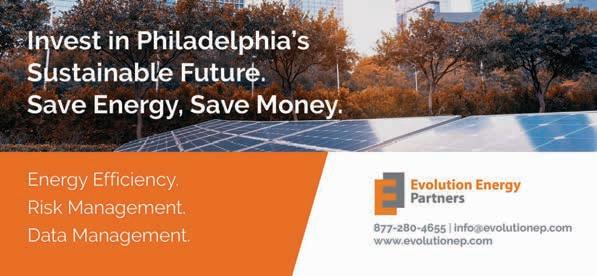
nationally with payments for water, gas and, increasingly, broadband and telecommunications affected. To avoid a crisis, the Pennsylvania Senate passed a $912 million coronavirus pandemic recovery aid bill, the majority of which ($570 million) would be divided among counties to help people pay utilities and rent.
Alternative energies are also on the agenda. Philadelphia has initiated a “Climate Action Playbook” that has committed the city to becoming carbon neutral by 2050. According to the city, a full 75% of Philadelphia’s emissions come from buildings and industry.
The playbook outlined these key goals and metrics:
• Reduce carbon pollution from the city-owned buildings and street lights 50% by 2030. • Reduce city operations’ energy use 20% by 2030. • Generate or purchase 100% of all electricity for city operations from renewable resources by 2030. • Provide critical long-term home repair in 25,000 low and moderate income single- and multifamily homes by 2026. • Provide energy and building improvements for 2,500 small food and grocery businesses by 2026. • Reduce school district energy use by 30% by 2026. • Create 10,000 jobs in energy e ciency and clean energy projects by 2026. • Achieve a clean electricity grid by 2050.
In 2020, Philadelphia looked into ways its infrastructure and governance could be improved by integrating “smart city” components into the city’s fabric, especially in using data and technology to confront inequities. The city launched a pilot program with the University of Pennsylvania and a data company, State of Place, in which 150 urban data points would be placed through the city, collect information and then inform the government of where work and resources need to be distributed.
The private sector is also doing its part when it comes to the envrionment. “There are many things going on in regard to environmental sustainability and we are doing our best to eliminate our carbon footprint,” said Joel Crouse, director of Stanwich Energy Advisors, in an interview with Invest:. “We’ve started to partner with a few select groups that provide energy efficiency programs to meet the needs that we are starting to see in New Jersey and here in Philadelphia. Customers are realizing the benefits associated with that, from an LED upgrade project to potentially putting up solar on their properties to eliminate that carbon footprint, basically because there has been legislation over the past few months regarding carbon emissions.”
Looking ahead As the region remained mired in the depths of a pandemic at the outset of 2021, many of the problems the sector faces are within the power of Philadelphians to conquer. It is reassuring to see that they are, whether it be embracing green technologies, keeping alive tax breaks for construction or engaging the community to train a labor force up to the task of continuing to build the region. Certainly, the picture looks far brighter than it did in the middle of the lockdown.
